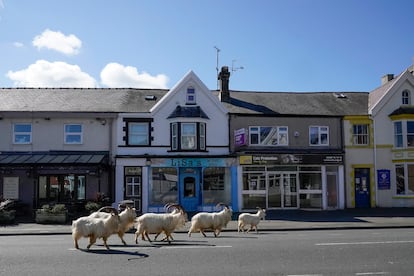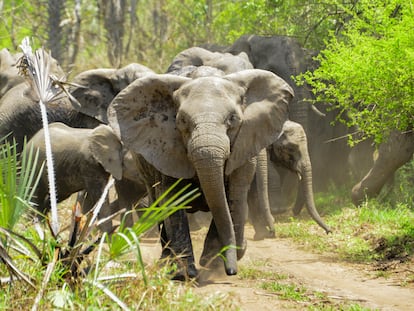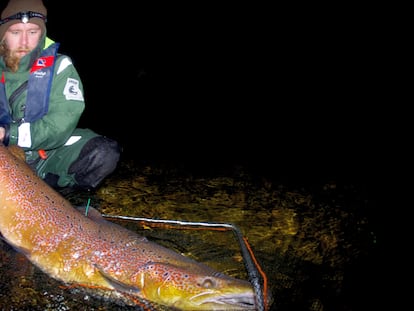The largest study of animal mobility during the Covid lockdown shows how humans disrupt wildlife
The GPS tracking of thousands of mammals confirmed that they moved more than usual, but only where strict confinement was applied over long distances

During the worst parts of the pandemic, when humans hid in our houses to escape from the virus, many animals began wandering through our cities. Although many of the videos of panthers, deer or badgers treading on asphalt turned out to be faked or recorded before the coronavirus, the exceptional situation has permitted scientists to analyze the flexibility of animal behavior. A work by 175 scientists, following 3,000 mammals during the strictest lockdown periods of the pandemic, has confirmed that they moved and approached highways more than usual. But the increase in mobility only occurred over long stretches and in zones where confinement was strictest. The authors of the study, published in Science, believe that not only human infrastructure harms wildlife: the mere presence of humans does, too.
The environmental impact of human constructions has been widely studied. On the borders of Asia and Europe, there are more than 30,000 kilometers of fences. On the European continent alone, one million artificial barriers interfere with the natural course of rivers. And half of Spain is less than a kilometer from a highway. Artificial interventions in the landscape, like roads and railways, have a triple negative effect: they put up barriers, insert humans and invasive species into the depths of wildlife, and, as has been seen with lynxes, they multiply traffic accidents. But what really affects wildlife: infrastructure or humans’ use of it? It isn’t easy to separate them. Only on exceptional occasions, like the creation of the Chernobyl exclusion zone, has it been possible to study the changes in animal behavior in the absence of humans. One such exception was the coronavirus lockdown, and scientists have used it to study humans’ true impact.
The study published in Science shows that animals approached highways up to 36% more during the relevant period. To measure it, scientists traced the journeys of 2,300 animals of 43 species in dozens of countries, thanks to the GPS collars they wore. But this increased closeness to roads only occurred in areas with a high human footprint, with a significant presence of infrastructure, agriculture and urbanized environments, and in regions with strict confinement measures.
The researchers used two metrics: the total distance traveled in 10 days and the distance traveled in an hour, representing the two extremes in travel patterns. The study’s principal author, Radboud University researcher Marlee Tucker, says that during the lockdown “animals traveled distances up to 73% longer than in the same period of 10 days of the previous year, when there was no lockdown.” The comparison with 2019 is one of the study’s strengths. The researchers have spent years following the same animals, and they compared the data with pre-pandemic times.
“Animals traveled distances up to 73% longer than in the same 10-day period the previous year.”Marlee Tucker, researcher at the Radboud University Nijmegen and lead author of the study
When it comes to animals that travel smaller distances, the opposite happened: the animals shortened their movements. “The response varied between individuals and species. Some traveled longer distances and others shorter, but on average there was a 12% decrease,” Tucker says in an email. “We don’t have the necessary data to measure the impact of the change on the animals, however, for some, it could be a pretty significant decrease,” she adds. These changes in pattern could be due to the fact that, in humans’ absence, the movements to avoid and escape from them decreased between February and May 2020, coinciding with the most severe months of lockdown, according to the study’s authors.

The Spaniard Nuria Selva, researcher at the Polish Academy of Sciences, spent all of the lockdown in the Białowieża National Park, one of the last virgin forests in Europe. As co-author of the study, she emphasizes that the changes in animal movement patterns depend on the degree of the lockdown: “The reduction was less in semi-urbanized and semi-natural zones. In those areas there were still people, as in parks, where human presence increased by more than 200%,” she says.
Beyond mobility, human presence can also affect animals’ physiology. In an unpublished study, Selva has demonstrated that cortisol levels — an indicator of stress — decreased in bears and chamois in Poland’s Montes Tatras National Park during the months of the lockdown.
“A road where no one passes is not a barrier, the barrier is the traffic, it is us.”Nuria Selva, researcher at the Polish Academy of Sciences and the University of Huelva
Selva points out another important aspect of the study: “It has allowed us to separate the impact of human infrastructure and humans. A highway where no one travels isn’t a barrier. The barrier is the traffic; the barrier is us.” Between 2013 and 2015, the Boise State University biologist Jesse Barber carried out a series of experiments with traffic. He recorded highway sounds and played them in natural environments where there was no asphalt. His results showed that on the so-called ghost highways, a significant percentage of birds disappeared. During the pandemic, the opposite phenomenon was observed: birds sang at lower frequencies and communicated better.
University of A Coruña biologist Alejandro Martínez Abraín notes the study’s statistical power, but he points out that the change in movement patterns has only been observed in areas with a greater human footprint, “in severe lockdown conditions and on the extremes of animal movement.” He also points out that the presence of wild animals in cities has not been studied.
“Not all animals prefer for people to move around less,” Martínez Abraín says. “For example, when it comes to highways, many prey species prefer for there to be a lot of movement, because that causes what in ecology is called a scarecrow effect, scaring away predators.” Starlings gather at crossroads, where they can’t be hunted. Red kite birds fly over railways looking for food. Rabbits nest alongside roads.
For the university professor, the changes in animal mobility patterns do not have to do with confinement. “We have to go back to the abandonment of the countryside. Animals have spent six or seven decades losing their fear of humans, urbanites who won’t do anything to them. Covid didn’t change that, the abandonment of the countryside did. What happened during the pandemia is that they took a step closer, and we realized something that was already happening.”
Sign up for our weekly newsletter to get more English-language news coverage from EL PAÍS USA Edition
Tu suscripción se está usando en otro dispositivo
¿Quieres añadir otro usuario a tu suscripción?
Si continúas leyendo en este dispositivo, no se podrá leer en el otro.
FlechaTu suscripción se está usando en otro dispositivo y solo puedes acceder a EL PAÍS desde un dispositivo a la vez.
Si quieres compartir tu cuenta, cambia tu suscripción a la modalidad Premium, así podrás añadir otro usuario. Cada uno accederá con su propia cuenta de email, lo que os permitirá personalizar vuestra experiencia en EL PAÍS.
¿Tienes una suscripción de empresa? Accede aquí para contratar más cuentas.
En el caso de no saber quién está usando tu cuenta, te recomendamos cambiar tu contraseña aquí.
Si decides continuar compartiendo tu cuenta, este mensaje se mostrará en tu dispositivo y en el de la otra persona que está usando tu cuenta de forma indefinida, afectando a tu experiencia de lectura. Puedes consultar aquí los términos y condiciones de la suscripción digital.
More information
Archived In
Últimas noticias
Most viewed
- Reinhard Genzel, Nobel laureate in physics: ‘One-minute videos will never give you the truth’
- Pablo Escobar’s hippos: A serious environmental problem, 40 years on
- Charles Dubouloz, mountaineering star, retires at 36 with a farewell tour inspired by Walter Bonatti
- Why we lost the habit of sleeping in two segments and how that changed our sense of time
- The fall of a prolific science journal exposes the billion-dollar profits of scientific publishing











































